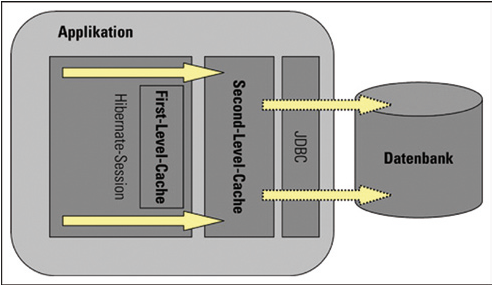Hibernate的一级缓存和二级缓存
- Fist level cache: This is enabled by default and works in session scope. Read more about hibernate first level cache.
- Second level cache: This is apart from first level cache which is available to be used globally in session factory scope.
一级缓存(不能disable):
- First level cache is associated with “session” object and other session objects in application can not see it.
- The scope of cache objects is of session. Once session is closed, cached objects are gone forever.
- First level cache is enabled by default and you can not disable it.
- When we query an entity first time, it is retrieved from database and stored in first level cache associated with hibernate session.
- If we query same object again with same session object, it will be loaded from cache and no sql query will be executed.
- The loaded entity can be removed from session using evict() method. The next loading of this entity will again make a database call if it has been removed using evict() method.
- The whole session cache can be removed using clear() method. It will remove all the entities stored in cache.
二级缓存默认是disable,需要自己配置

How second level cache works:
Lets write all the facts point by point:
- Whenever hibernate session try to load an entity, the very first place it look for cached copy of entity in first level cache (associated with particular hibernate session).
- If cached copy of entity is present in first level cache, it is returned as result of load method.
- If there is no cached entity in first level cache, then second level cache is looked up for cached entity.
- If second level cache has cached entity, it is returned as result of load method. But, before returning the entity, it is stored in first level cache also so that next invocation to load method for entity will return the entity from first level cache itself, and there will not be need to go to second level cache again.
- If entity is not found in first level cache and second level cache also, then database query is executed and entity is stored in both cache levels, before returning as response of load() method.
- Second level cache validate itself for modified entities, if modification has been done through hibernate session APIs.
- If some user or process make changes directly in database, the there is no way that second level cache update itself until “timeToLiveSeconds” duration has passed for that cache region. In this case, it is good idea to invalidate whole cache and let hibernate build its cache once again. You can use below code snippet to invalidate whole hibernate second level cache.
refer:https://howtodoinjava.com/hibernate/understanding-hibernate-first-level-cache-with-example/
https://howtodoinjava.com/hibernate/how-hibernate-second-level-cache-works/
Hibernate的一级缓存和二级缓存的更多相关文章
- 【转】hibernate缓存:一级缓存和二级缓存
什么是缓存? 缓存是介于物理数据源与应用程序之间,是对数据库中的数据复制一份临时放在内存中的容器,其作用是为了减少应用程序对物理数据源访问的次数,从而提高了应用程序的运行性能.Hibernate在进行 ...
- Hibernate中的一级缓存、二级缓存和懒加载(转)
1.为什么使用缓存 hibernate使用缓存减少对数据库的访问次数,从而提升hibernate的执行效率.hibernate中有两种类型的缓存:一级缓存和二级缓存. 2.一级缓存 Hibenate中 ...
- Hibernate一级缓存与二级缓存的区别
一级缓存: 就是Session级别的缓存.一个Session做了一个查询操作,它会把这个操作的结果放在一级缓存中. 如果短时间内这个session(一定要同一个session)又做了同一个操作,那么h ...
- Hibernate中一级缓存和二级缓存使用详解
一.一级缓存二级缓存的概念解释 (1)一级缓存就是Session级别的缓存,一个Session做了一个查询操作,它会把这个操作的结果放在一级缓存中,如果短时间内这个 session(一定要同一个ses ...
- Hibernate中的一级缓存、二级缓存和懒加载
1.为什么使用缓存 hibernate使用缓存减少对数据库的访问次数,从而提升hibernate的执行效率.hibernate中有两种类型的缓存:一级缓存和二级缓存. 2.一级缓存 Hibenate中 ...
- hibernate缓存:一级缓存和二级缓存
1.什么是缓存? 缓存是介于物理数据源与应用程序之间,是对数据库中的数据复制一份临时放在内存中的容器,其作用是为了减少应用程序对物理数据源访问的次数,从而提高了应用程序的运行性能.Hibernate在 ...
- Hibernate一级缓存和二级缓存深度比较
1.什么是缓存 缓存是介于应用程序和物理数据源之间,其作用是为了降低应用程序对物理数据源访问的频次,从而提高了应用的运行性能.缓存内的数据是对物理数据源中的数据的复制,应用程序在运行时从缓存读写数据, ...
- Hibernate一级缓存和二级缓存详解
(1)一级缓存 是Session级别的缓存,一个Session做了一个查询操作,它会把这个操作的结果放在一级缓存中,如果短时间内这个session(一定要同一个session)又做了同一个操作,那么h ...
- Hibernate之一级缓存和二级缓存
1:Hibernate的一级缓存: 1.1:使用一级缓存的目的是为了减少对数据库的访问次数,从而提升hibernate的执行效率:(当执行一次查询操作的时候,执行第二次查询操作,先检查缓存中是否有数据 ...
- Hibernate 的一级缓存和二级缓存总结
缓存:缓存是什么,解决什么问题? 位于速度相差较大的两种硬件/软件之间的,用于协调两者数据传输速度差异的结构,均可称之为缓存Cache.缓存目的:让数据更接近于应用程序,协调速度不匹配,使访问速度更快 ...
随机推荐
- 密码学系列之:Merkle–Damgård结构和长度延展攻击
密码学系列之:Merkle–Damgård结构和长度延展攻击 简介 Merkle–Damgård结构简称为MD结构,主要用在hash算法中抵御碰撞攻击.这个结构是一些优秀的hash算法,比如MD5,S ...
- JavaScript学习笔记:你必须要懂的原生JS(一)
1.原始类型有哪几种?null是对象吗?原始数据类型和复杂数据类型存储有什么区别? 原始类型有6种,分别是undefined,null,bool,string,number,symbol(ES6新增) ...
- python3.7 jack棋牌11点实例
# -*- codeing: utf-8 -*- # Project: 棋牌游戏11点 # Author: jack # Version: 2.2 # Start Time: 2021-07-24 i ...
- 2021 NOI冬令营
2021 NOI冬令营 -- 本来想写得稍微文艺一点的,但是停课这么久已经退化到不会写文章了. 毕竟省选了我才来补的,时间也过去很久了. 毕竟这次我没有获得任何奖项. 我唯一的获得就是-- --好好看 ...
- Xshell记录Linux连接操作日志遇到的坑
1.问题描述: 在Windows上,以前一直使用Secure CRT连接Linux主机进行远程操作,使用CRT的日志功能记录连接过程中的所有操作以及输出. 最近(2019-8-17)使用Xshell进 ...
- Python自动化测试面试题-MySQL篇
目录 Python自动化测试面试题-经验篇 Python自动化测试面试题-用例设计篇 Python自动化测试面试题-Linux篇 Python自动化测试面试题-MySQL篇 Python自动化测试面试 ...
- python errno库与socket.connect_ex()方法的结合使用
前言:一般socket链接会首选connect方法,该方法会一直尝试链接.那么今天展示下connect_ex()方法,该方法如果链接成功会返回0,失败会返回errno库中的errorcode中的key ...
- CAS 原理 应用
原子CAS操作 原子操作指令里,有原子加,原子减,cas到底是什么呢? 首先看一段代码, bool compare_and_swap(int *accum, int *dest, int newval ...
- atom之插件安装及相关
1. simplified-chinese-menu 汉化软件 2. file-icons 加上文件图标 3. language-vue 加上vue语言支持 4. platformio-ide-ter ...
- 记录21.07.22 —— Vue.js基础(一)
VUE基础 语雀课件地址 Vue.js框架 Vue中文文档 Vue.js 创建vue项目 ①在一个空项目中引入vue的js文件 <script src="https://cdn.jsd ...
